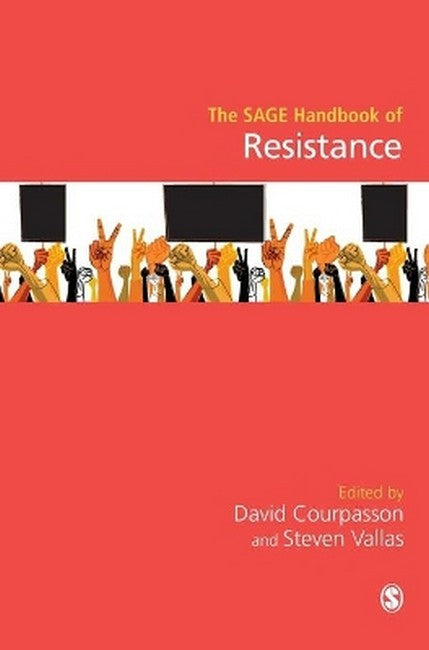Resistance Studies: A Critical Introduction - David Courpasson and Steven Vallas PART ONE: FOUNDATIONS Chapter 1: Globalization, Resistance, and Social Transformation - Jeffrey Juris and Marina Sitrin Chapter 2: Emerging Subjectivity in Protest - Bob Kurik Chapter 3: Islam: Fundamentalism and Insurgency in the Arab Spring - Valentine M. Moghadam Chapter 4: The Grand Refusal?: Struggling with Alternative Foucauldian-Inspired Approaches to Resistance at Work - David Knights Chapter 5: Resisting the 24/7 Work Ethic - Shifting Modes of Regulation and Refusal in Organized Employment - Andre Spicer and Peter Fleming PART TWO: SITES OF RESISTANCE Chapter 6: The Body as a Site of Resistance - Erynn Masai de Casanova & Afshan Jafar Chapter 7: The Complexities and Contradictions of Resistance: An Intersectional Perspective - Amanda M. Gengler Chapter 8: Individual Constraint and Group Solidarity: Marginalized Mothers and the Paradox of Family Responsibility - Jillian Crocker Chapter 9: Protecting Our Children: Paradoxes of Resistance in an Era of Neoliberal Education - Linda Blum & Shelley Kimelberg Chapter 10: Resistance in Organizational Strategy-Making - Anniina Rantakari and Eero Vaara Chapter 11: Prisons as Sites of Power and Resistance - Tammi Arford PART THREE: TECHNOLOGIES OF POWER AND RESISTANCE Chapter 12: Recasting Community for Online Resisting Work - Felipe G. Massa Chapter 13: Between Grassroots and 'Astroturf': Understanding Mobilization from the Top-down - Edward T. Walker Chapter 14: From Digital Tools to Political Infrastructure - Marianne Maeckelbergh Chapter 15: Resisting the New: On Cooptation and the Organisational Conditions for Entrepreneurship - Daniel Hjorth PART FOUR: LANGUAGES OF RESISTANCE Chapter 16: Musical Style, Youth Subcultures, and Cultural Resistance - Ryan Moore Chapter 17: Graffitti as Infrapolitics: A Study of Visual Interventions of Resistance in San Francisco - Guillaume Marche Chapter 18: Naming, Shaming, Changing the World - Gay Seidman Chapter 19: Contesting Authority in a Moralized Market: The Case of a Catholic Hospital Unionization Campaign - Adam Reich Chapter 20: Organizational Change and Resistance: An Identity Perspective - Sierk Ybema, Robyn Thomas & Cynthia Hardy PART FIVE: GEOGRAPHIES OF RESISTANCE Chapter 21: The World Social Forum and Global Resistance: The Trajectory of an Activist Open Space - Giuseppe Caruso Chapter 22: Back to Work: Resisting Clientelism in a Poor Neighborhood of Buenos Aires - Pablo Fernandez Chapter 23: Bases of Governance and Forms of Resistance: The Case of Rural China - Xueguang Zhou & Yun Ai Chapter 24: Resistance and its Pitfalls: Analyzing NGO and Civil Society Politics in Bangladesh - Lamia Karim Chapter 25: Urban Gardening: Between Green Resistance and Ideological Instrument - Sandrine Baudry & Emeline Eudes
Request Academic Copy
Please copy the ISBN for submitting review copy form
Description
Resistance takes many forms, and is aimed in many directions. The editors have given us a powerful new language for grasping this diversity by cleverly dividing the handbook into foundations, sites, technologies, languages, and geographies of resistance. This book should attract wide attention and will reverberate across many disciplines. -- James M. Jasper The Editors have assembled a collection of expert articles traversing sources in time and space on what it is to 'resist'. These argue that resistance studies is an interdisciplinary area looking, in part, at 'the art of the weak', 'the weapons of the weak', 'style warfare', 'the great refusal', 'inaction', and 'rebellion'. On (or perhaps in) the other hand, there is a consideration of 'co-optation', 'accommodation' and 'commodification' as all equally associated with resistance. The articles move through different depths of visibility e.g. resistance is 'underground', 'rhizomatic', 'grass roots', 'astroturf' or as fully 'out in the open'. But all are aware of the context-specific nature of resistance in a major text that will illuminate many contemporary features of a world in which power differentials appear to be increasing and where the 1% may yet come to fear a call from a resistant mob armed with pitchforks. -- Gibson Burrell Resistance is the new normal. Anti-elite resistance in politics, both nationally as in Brexit and organisationally, in the role of Trump and Corbyn in their respective parties as well as in social movements globally and in the interstices of organisations that seem increasingly out of kilter with the spirit of the times is a major contemporary phenomenon. While no relations of power are ever alike that are resisted and no resistance follows universal scripts - both power and resistance are highly contextual - the Handbook of Resistance offers an invaluable resource understanding the dialectical relations of power and resistance theoretically and through many insightful empirical analyses. I recommend it as essential reading for the social sciences. -- Stewart Clegg In conceiving and making available this rich interdisciplinary and globally-oriented handbook, Courpasson and Vallas are doing a great service to social scientists committed to social change. This book is an important resource that should become widely used and widely referenced. -- Michele Lamont

